 W
WChalcid wasps are insects within the superfamily Chalcidoidea, part of the order Hymenoptera. The superfamily contains some 22,500 known species, and an estimated total diversity of more than 500,000 species, meaning the vast majority have yet to be discovered and described. The name "chalcid" is often confused with the name "chalcidid", though the latter refers strictly to one constituent family, the Chalcididae, rather than the superfamily as a whole; accordingly, most recent publications (e.g.,) use the name "chalcidoid" when referring to members of the superfamily.
 W
WChalcid wasps are insects within the superfamily Chalcidoidea, part of the order Hymenoptera. The superfamily contains some 22,500 known species, and an estimated total diversity of more than 500,000 species, meaning the vast majority have yet to be discovered and described. The name "chalcid" is often confused with the name "chalcidid", though the latter refers strictly to one constituent family, the Chalcididae, rather than the superfamily as a whole; accordingly, most recent publications (e.g.,) use the name "chalcidoid" when referring to members of the superfamily.
 W
WBaeomorpha is an extinct genus of rotoitid parasitic wasp, known from the Late Cretaceous of Laurasia. The type species, B. dubitata was named by Charles Thomas Brues for a specimen found in 72 million year old Canadian Amber. The vast majority of species are known from the Russian Taimyr amber, of upper Santonian age but two species are known from the upper Campanian Canadian amber, while one species is known from the lower Cenomanian Burmese amber.
 W
WBrachymeria is a genus of parasitic wasps in the family Chalcididae. Over 300 species are known worldwide, all of them parasites of insect pupae. Most species are black with limited yellow markings, and like most chalcidid wasps, they have enlarged hind femora. The female typically lays eggs inside the pupae of a lepidopteran using its ovipositor. Although mostly parasitic on Lepidoptera, a few are hyperparasites, or attack other types of insect larvae. The adult parasites emerge typically from the host pupa. Some species have been used in biological control.
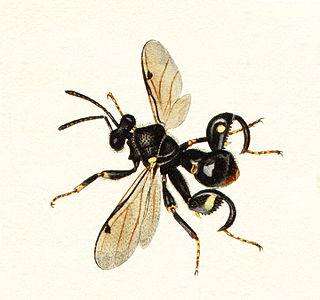 W
WThe Chalcididae are a moderate-sized family within the Chalcidoidea, composed mostly of parasitoids and a few hyperparasitoids. The family is apparently polyphyletic, though the different subfamilies may each be monophyletic, and some may be elevated to family status in the near future. As presently defined, there are over 85 genera and over 1460 species worldwide. They are often black with yellow, red, or white markings, rarely brilliantly metallic, with a robust mesosoma and very strong sculpturing. The hind femora are often greatly enlarged, with a row of teeth or serrations along the lower margin.
 W
WChalcidinae is a subfamily of chalcidid wasps in the family Chalcididae. There are about 6 genera and 17 described species in Chalcidinae.
 W
WChalcidini is a wasp tribe in subfamily Chalcidinae.
 W
WChalcis is a wasp genus in the tribe Chalcidini.
 W
WConura is a genus of chalcidid wasps in the family Chalcididae, containing more than 300 species described. They are distributed mostly in the New World, especially in the Neotropical region, where 279 species occur. Conura is divided into three subgenera and 63 species groups, which may not form taxonomic entities but reflect patterns of morphology that are useful for focused studies.
 W
WDirhinus is a genus of parasitic wasps in the family Chalcididae. The genus has a worldwide distribution.
 W
WDiversinitidae are an extinct family of Chalcid wasps. Three genera are known, all from the early Cenomanian aged Burmese amber. They are distinguished by the presence of multiporous plate sensilla on the first flagellomere in both sexes. They are among the most basal and earliest known members of Chalcidoidea.
 W
WDiversitinus is an extinct genus of Chalcid wasp, belonging to the extinct family Diversinitidae, of which it is the type genus. It contains a single species D. attenboroughi known from 2 male specimens from the earliest Cenomanian aged Burmese amber of the Hukawng Valley in Myanmar, around 99 million years old. The genus name originates from the Latin diversus, meaning different or diverse and initus which means origin or start, reflecting the great diversity of Chalcid wasps. The species name is taken from the famous naturalist and broadcaster David Attenborough.
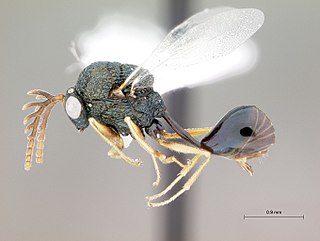 W
WThe Eucharitidae are a family of parasitic wasps. Eucharitid wasps are members of the superfamily Chalcidoidea and consist of three subfamilies: Oraseminae, Eucharitinae, and Gollumiellinae. Most of the 55 genera and 417 species of Eucharitidae are members of the subfamilies Oraseminae and Eucharitinae, and are found in tropical regions of the world.
 W
WEucharitinae is a subfamily of chalcid wasps in the family Eucharitidae.
 W
WEuperilampus is a genus of chalcid wasps in the family Perilampidae. There are about 18 described species in Euperilampus.
 W
WEuperilampus triangularis is a species of chalcid wasp in the family Perilampidae.
 W
WFig wasps are wasps of the superfamily Chalcidoidea which spend their larval stage inside figs. Most are pollinators but others simply feed off the plant. The non-pollinators belong to several groups within the superfamily Chalcidoidea, while the pollinators are in the family Agaonidae. While pollinating fig wasps are gall-makers, the remaining types either make their own galls or usurp the galls of other fig wasps; reports of them being parasitoids are considered dubious.
 W
WHaltichella is a genus of chalcidid wasps in the family Chalcididae. There are at least 20 described species in Haltichella.
 W
WHaltichellinae is a subfamily of chalcidid wasps in the family Chalcididae.
 W
WKapala is a genus of parasitic wasps in the family Eucharitidae, found primarily in the neotropics, and associated with ants.
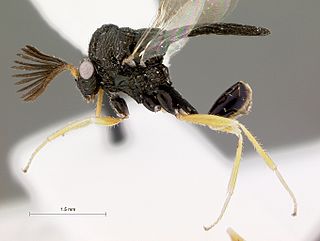 W
WLatina is a genus of South American chalcid wasps in the family Eucharitidae. There are four known species of Latina with three known in Argentina and one from Venezuela.
 W
WThe Leucospidae are a specialized group of wasps within the superfamily Chalcidoidea, that are ectoparasitoids of aculeate wasps or bees. They are typically mimics of bees or stinging wasps, often black with yellow, red, or white markings, sometimes metallic, with a robust mesosoma and very strong sculpturing. The hind femora are often greatly enlarged, with a row of teeth or serrations along the lower margin as in Chalcididae. The wing has a longitudinal fold. The female ovipositor is sometimes short, but if not, it is recurved and lies along the dorsal side of the metasoma, a unique feature. The males are also unusual, in the fusion of many of the metasomal segments to form a capsule-like "carapace".
 W
WLeucospis is a genus of wasps belonging to the family Leucospidae. Most species are brightly coloured with yellow and black patterning and about 2 cm long. They have characteristically enlarged femurs on the hind leg with the lower margin toothed. The wings have a longitudinal fold and the long ovipositor is bent over their backs above the abdomen or metasoma. They are parasitic on wasps and solitary bees that construct cells and provision food for their offspring. The Leucospis larvae live and grow as ectoparasites of the host larvae. Usually, only, one parasite emerges from a single cell. The genus Micrapion from South Africa is very closely related and phylogenetic studies suggest merging of the two genera. The genus Leucospis is found across the world in the tropical regions.
 W
WLeucospis dorsigera is a species of wasp belonging to the family Leucospidae.
 W
WMegastigmidae is a family of chalcid wasps in the order Hymenoptera. There are about 12 genera and more than 170 described species in Megastigmidae. Megastigmidae was formerly considered a subfamily of the family Torymidae.
 W
WMegastigmus is a genus of minute wasps. There are more than 134 described species, more than half of which undergo larval development within the seeds of trees and shrubs.
 W
WMegastigmus atedius is a species of minute wasp that feeds on white spruce seed and cones. The damage it causes is largely undetected because the larvae complete their development hidden inside the seeds, which reveal no external indication of this. Although species of Megastigmus are said to be host-specific, the spruce seed chalcid found near Fairbanks, Alaska, was identified by E.H. Holsten and others in 1980 as M. piceae, while A.H. Rose and O.H. Lindquist applied the name Megastigmus piceae, but gave the authority as Rohwer.
 W
WMegastigmus transvaalensis is a species of minute wasp that feeds on Schinus terebinthifolius seeds.
 W
WMonodontomerus is a genus of chalcid wasps in the family Torymidae.
 W
WObeza is a genus of chalcid wasps in the family Eucharitidae. There are about eight described species in Obeza.
 W
WObeza floridana is a species of chalcid wasp in the family Eucharitidae.
 W
WOrasema is a genus of chalcid wasps in the family Eucharitidae. There are at least 50 described species in Orasema.
 W
WOrasema occidentalis is a species of chalcid wasp in the family Eucharitidae.
 W
WThe Ormyridae are a small family of parasitic wasps in the superfamily Chalcidoidea. They are either parasitoids or hyperparasitoids on gall-forming insects, primarily cynipid wasps and tephritid flies. The 120 or so species in three genera are cosmopolitan, except almost entirely absent from South America.
 W
WOrmyrus is a genus of chalcid wasps in the family Ormyridae. There are at least 120 described species in Ormyrus.
 W
WTorymus is a genus of chalcid wasps from the family Torymidae which was named by the Swedish naturalist Johan Wilhelm Dalman in 1820. Most species are ectoparasitoids of gall forming insects. There are more than 400 spp. worldwide.
 W
WThe Perilampidae are a small family within the Chalcidoidea, composed mostly of hyperparasitoids. The family is closely related to the Eucharitidae, and the eucharitids appear to have evolved from within the Perilampidae, thus rendering the family paraphyletic. As presently defined, at least 15 genera and 270 species are described worldwide. They are often brilliantly metallic, with robust mesosomae and a small, triangular metasomae. They are generally very strongly sculptured. The prothorax is typically very broad and disc-like, and the labrum is multidigitate, a feature shared with the Eucharitidae.
 W
WPhasgonophora is a genus of chalcidid wasps in the family Chalcididae. There are at least two described species in Phasgonophora.
 W
WPhasgonophora sulcata is a species of chalcidid wasp in the family Chalcididae.
 W
WPseudochalcura is a genus of chalcid wasps in the family Eucharitidae. There are about 14 described species in Pseudochalcura.
 W
WPseudochalcura gibbosa is a species of chalcid wasp in the family Eucharitidae.
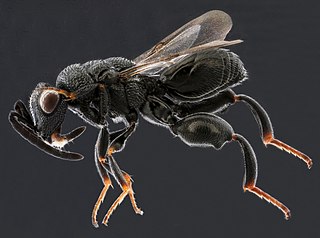 W
WPsilochalcis is a genus of chalcidid wasps in the family Chalcididae. There are at least 20 described species in Psilochalcis.
 W
WThe Rotoitidae are a very small family of rare, relictual parasitic wasps in the superfamily Chalcidoidea, known primarily from fossils. Only two extant species are known, each in its own genus, one from New Zealand and one from Chile, and little is known about their biology. Females of the Chilean species, Chiloe micropteron, have their wings reduced to tiny bristles. Most fossil species are known from the Taimyr amber of Russia and Canadian amber, but one species, Baeomorpha liorum is known from the Burmese amber.
 W
WThe Tetracampidae are a small family of parasitic wasps in the superfamily Chalcidoidea. They are parasitoids of phytophagous insects, primarily flies. The 44 species in 15 genera are almost entirely absent from the New World.
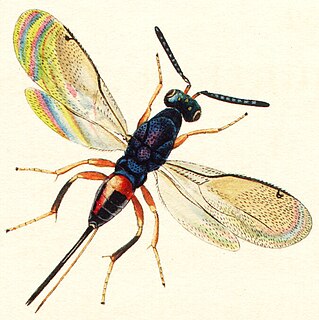 W
WThe Torymidae are a family of wasps that consists of attractive metallic species with enlarged hind legs, and generally with long ovipositors in the females. Many are parasitoids on gall-forming insects, and some are phytophagous (plant-eating) species, sometimes usurping the galls formed by other insects. Over 960 species in about 70 genera are found worldwide. They are best recognized in that they are one of the few groups of Chalcidoidea in which the cerci are visible.
 W
WTorymus is a genus of chalcid wasps from the family Torymidae which was named by the Swedish naturalist Johan Wilhelm Dalman in 1820. Most species are ectoparasitoids of gall forming insects. There are more than 400 spp. worldwide.
 W
WTorymus tubicola is a species of chalcid wasp in the family Torymidae.